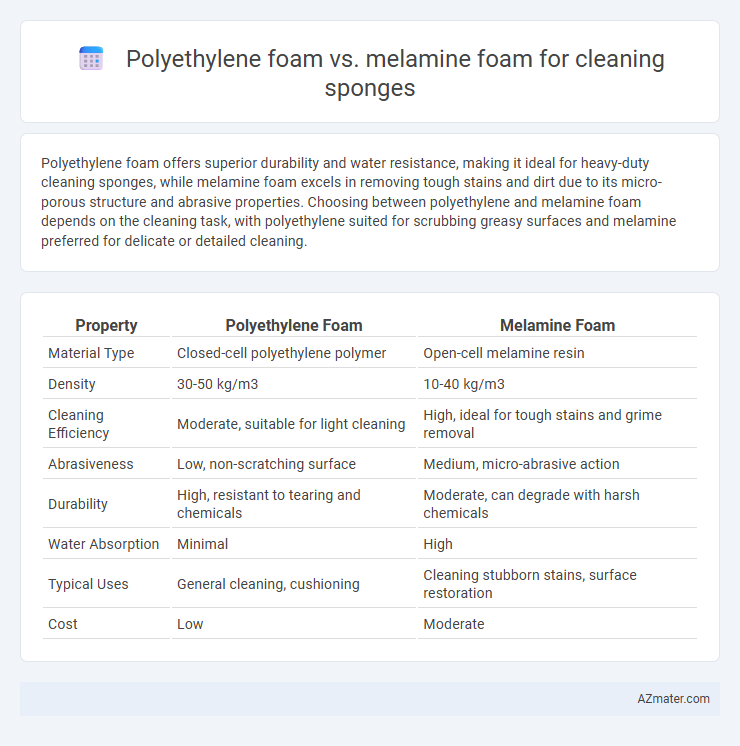Polyethylene foam offers superior durability and water resistance, making it ideal for heavy-duty cleaning sponges, while melamine foam excels in removing tough stains and dirt due to its micro-porous structure and abrasive properties. Choosing between polyethylene and melamine foam depends on the cleaning task, with polyethylene suited for scrubbing greasy surfaces and melamine preferred for delicate or detailed cleaning.
Table of Comparison
| Property | Polyethylene Foam | Melamine Foam |
|---|---|---|
| Material Type | Closed-cell polyethylene polymer | Open-cell melamine resin |
| Density | 30-50 kg/m3 | 10-40 kg/m3 |
| Cleaning Efficiency | Moderate, suitable for light cleaning | High, ideal for tough stains and grime removal |
| Abrasiveness | Low, non-scratching surface | Medium, micro-abrasive action |
| Durability | High, resistant to tearing and chemicals | Moderate, can degrade with harsh chemicals |
| Water Absorption | Minimal | High |
| Typical Uses | General cleaning, cushioning | Cleaning stubborn stains, surface restoration |
| Cost | Low | Moderate |
Introduction to Polyethylene and Melamine Foam
Polyethylene foam is a closed-cell foam known for its durability, water resistance, and cushioning properties, making it effective for gentle cleaning tasks and absorbing liquids. Melamine foam is an open-cell foam with microstructures that provide high abrasiveness, allowing it to remove stains and dirt without harsh chemicals. Understanding these materials' unique textures and chemical compositions helps determine their suitability as cleaning sponges for various surfaces.
Composition and Manufacturing Differences
Polyethylene foam is a closed-cell polymer made from ethylene monomers, produced through a foaming process that traps gas bubbles within the plastic matrix, resulting in a dense, durable sponge ideal for scrubbing tasks. Melamine foam is an open-cell material derived from a thermosetting resin called melamine-formaldehyde, manufactured via a polymerization process that creates a rigid, microporous structure, making it highly effective for fine cleaning and polishing. The key difference lies in polyethylene's flexible, water-resistant composition versus melamine's hard, abrasive quality due to its unique microstructure.
Cleaning Performance Comparison
Polyethylene foam offers excellent durability and moderate abrasion resistance, making it effective for general cleaning tasks on various surfaces without causing damage. Melamine foam provides superior cleaning performance by its micro-porous structure that acts as a fine abrasive, efficiently removing tough stains and grime without chemicals. While polyethylene foam excels in longevity and cushioning, melamine foam delivers enhanced stain removal and surface restoration, particularly on hard and delicate materials.
Durability and Lifespan
Polyethylene foam offers superior durability and a longer lifespan compared to melamine foam, making it ideal for heavy-duty cleaning tasks. Its closed-cell structure resists wear and tear, chemical damage, and water absorption, extending the sponge's usability over time. In contrast, melamine foam, while effective for stain removal, tends to degrade faster due to its open-cell design and brittleness under frequent use.
Abrasiveness and Surface Safety
Polyethylene foam offers moderate abrasiveness suitable for removing dirt without damaging most surfaces, making it ideal for general cleaning tasks. Melamine foam provides higher abrasiveness due to its microstructure, effectively tackling stubborn stains but posing a risk to delicate surfaces by causing scratches or dullness. Choosing between the two depends on balancing cleaning power with surface sensitivity to ensure effective yet safe cleaning results.
Water Absorption and Drying Time
Polyethylene foam exhibits low water absorption, making it resistant to soaking and quick to dry, which is ideal for repetitive cleaning tasks without prolonged wetness. Melamine foam, however, has higher water absorption due to its open-cell structure, allowing it to retain more moisture but requiring longer drying times post-use. The rapid drying characteristic of polyethylene foam enhances hygiene by reducing bacterial growth risk compared to melamine foam sponges that stay damp longer.
Cost Analysis and Availability
Polyethylene foam cleaning sponges generally offer lower production costs due to their widespread industrial use and availability of raw materials, making them more budget-friendly for bulk purchases. Melamine foam sponges, though priced higher, provide superior cleaning performance and durability, which can justify the initial investment in specialized cleaning applications. Availability of polyethylene foam is more consistent across various markets, while melamine foam may face supply fluctuations and higher import costs depending on the region.
Environmental Impact and Recyclability
Polyethylene foam used in cleaning sponges is typically non-biodegradable and challenging to recycle, contributing to long-term environmental pollution due to its persistence in landfills. Melamine foam, while effective for cleaning, also poses environmental concerns as it is not biodegradable and difficult to recycle, often ending up as microplastic waste. Both materials require improved recycling processes, but polyethylene foam's widespread use in packaging increases its overall environmental footprint compared to the specialized but less common melamine foam sponges.
Recommended Uses for Each Foam Type
Polyethylene foam is recommended for heavy-duty cleaning tasks due to its durability, abrasion resistance, and ability to absorb oils and solvents, making it ideal for automotive and industrial cleaning. Melamine foam excels in light-duty cleaning and polishing applications, particularly effective for removing stains, dirt, and marks from smooth surfaces like walls, glass, and electronics without scratching. Each foam type's porosity and texture dictate its optimal cleaning context, with polyethylene foam suited for scrubbing tough residues and melamine foam preferred for gentle surface restoration.
Final Verdict: Which Foam is Better for Cleaning Sponges?
Polyethylene foam offers superior durability, water resistance, and gentle scrubbing capabilities ideal for everyday cleaning tasks, while melamine foam provides exceptional micro-abrasive properties for tough stains and deep cleaning on delicate surfaces. Choosing the best foam depends on cleaning needs--polyethylene is better for general use and repeated wet conditions, whereas melamine excels in removing stubborn grime without harsh chemicals. For versatile household cleaning sponges, polyethylene foam is often the preferred material due to its balance of resilience and effective cleaning performance.

Infographic: Polyethylene foam vs Melamine foam for Cleaning sponge
 azmater.com
azmater.com